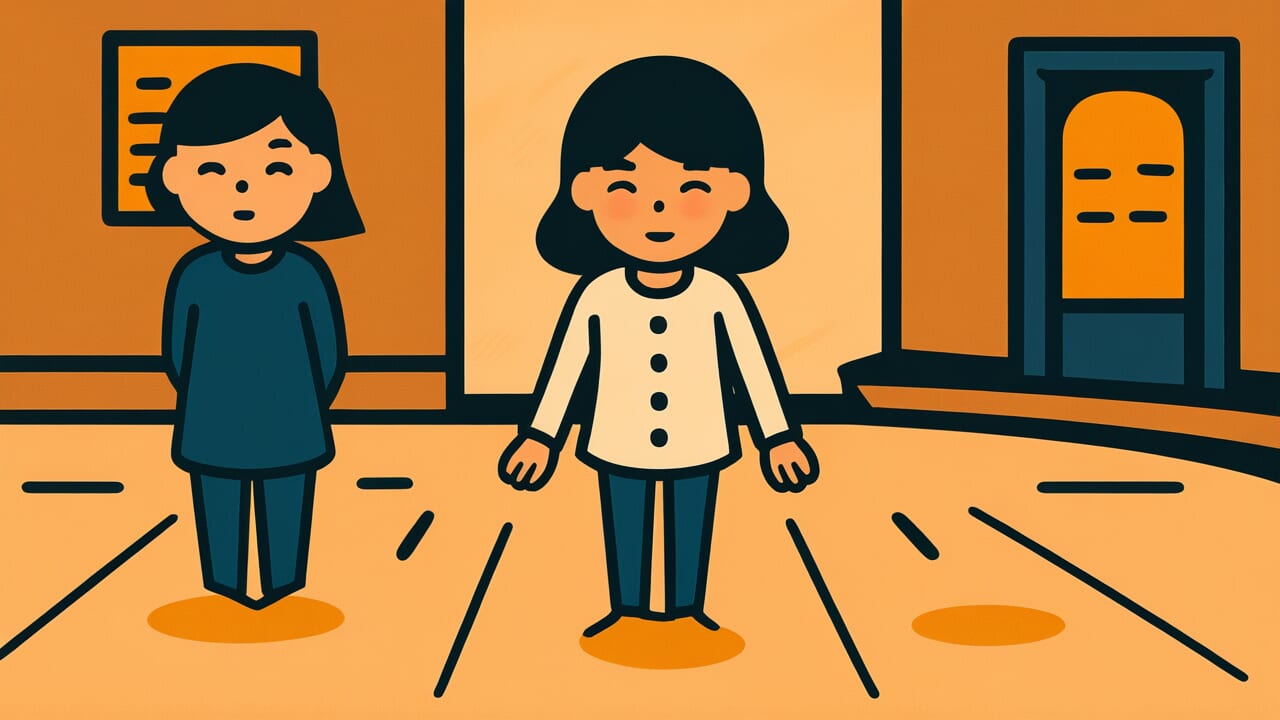How to Read “Stand with feet together and look with narrowed eyes”
Ashi wo kasanete tachi, me wo sobatete miru
Meaning of “Stand with feet together and look with narrowed eyes”
This proverb describes behaving modestly according to proper etiquette. Specifically, it refers to standing properly with feet aligned and looking at others with slightly lowered eyes. This shows a humble and modest attitude.
This expression is used when showing respect to superiors or in formal situations. You restrain yourself and show respect to others. You avoid being intimidating and approach with a humble posture.
In modern terms, it means maintaining proper posture while being careful not to make others feel pressured by your presence.
Today, we rarely practice such strict etiquette in daily life. However, the essence of politeness remains unchanged.
In situations requiring proper behavior like interviews or ceremonies, such modest conduct is still valued. In an era that emphasizes self-assertion, the ability to show humility when appropriate is being reconsidered.
Origin and Etymology
This proverb expresses behavior from traditional Japanese etiquette. The exact first written appearance is unclear. However, it likely came from manners valued in samurai and court noble societies.
“Stand with feet together” means standing with both feet aligned closely. This resembles the modern attention stance. In traditional etiquette, standing with feet apart was considered rude. Aligning your feet showed a modest and humble attitude.
“Look with narrowed eyes” uses “sobatete,” which means looking with narrowed, downcast eyes. Old Japanese had the verb “sobameru,” meaning to tilt or slant.
Staring directly at someone was considered rude. Lowering your eyes slightly and softening your gaze was proper etiquette.
Combining these two actions expresses humility and respect through your entire body. Similar expressions appear in Edo period etiquette books. This suggests the proverb captures behavior long cherished as a Japanese virtue.
Usage Examples
- The tea ceremony teacher stood with feet together and looked with narrowed eyes, truly embodying proper etiquette
- She maintained the posture of standing with feet together and looking with narrowed eyes during her first greeting, conveying her good upbringing
Universal Wisdom
The universal wisdom this proverb conveys is that humility is not just a state of mind. It must be expressed through your entire body. Humans communicate their inner selves not only through words but also through nonverbal elements like posture and gaze.
Why did our ancestors pay attention to details like foot position and eye direction? They knew that true respect reaches others only through form.
No matter how much you respect someone in your heart, those feelings won’t reach them if your attitude doesn’t show it. Conversely, arranging your form naturally arranges your heart. This was their experiential wisdom.
This proverb has been passed down because it contains an eternal truth about human relationships. In any era, people waver between the desire to appear larger and the wish to respect others.
Amid that conflict, this proverb teaches the beauty and strength of choosing to make yourself smaller.
Modest behavior is not weakness but a sign of strength in self-control. Only those who can restrain themselves can open others’ hearts. This depth of human understanding is the universal value this proverb holds.
When AI Hears This
The human brain makes judgments while constantly monitoring the body’s state. This is called “embodied cognition” in cognitive science. Remarkably, this proverb accurately captures how two physical actions distort cognition.
First, consider “standing with feet together,” an unstable posture. The brain uses massive computational resources to maintain balance. The cerebellum and vestibular system constantly work on posture control.
Neural circuits that could be used for thinking and judgment are diverted to maintaining posture. Research shows that solving problems in unstable postures like standing on one foot reduces accuracy by about 15 percent. Physical instability creates mental instability.
More interesting is “looking with narrowed eyes,” which distorts vision. Looking at things from an angle not only distorts the image on the retina. It also changes information processing patterns in the brain’s visual cortex.
Compared to frontal viewing, judgment accuracy for depth and distance decreases. Bias also affects how you evaluate an object’s importance. When your gaze is angled, your brain unconsciously judges “this is an unimportant object.”
The essence of this proverb is the insight that physical “sloppiness” in the body directly connects to cognitive “sloppiness.” Correcting your posture is not just etiquette. It’s a rational strategy to maximize your brain’s information processing capacity.
Lessons for Today
This proverb teaches modern people the importance of balancing self-expression and humility. Now that promoting yourself on social media is normal, perhaps it’s time to reconsider the value of taking a step back.
Modern society encourages behaving confidently and boldly. That itself is wonderful. However, you don’t need to be that way in every situation.
When you want to build trust with someone you just met, when you want to value team harmony, when you want to listen to others. In such situations, a modest attitude becomes the key that opens doors.
Specifically, before asserting your opinion in a meeting, first listen to others with proper posture. In presentations, show confidence while humbly listening to questions. People who can make such distinctions are truly mature adults.
The humility within you is never weakness. It’s your precious strength for respecting others and building deeper relationships. Try using that strength depending on the time and situation.



Comments